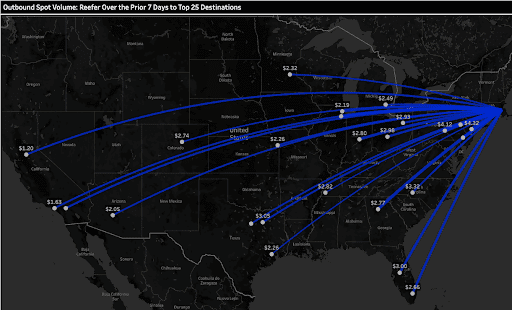Refrigerated carriers know Route 128 in Boston is literally the end of the line when it comes to finding loads. At the end of the country’s longest north-south interstate, I-95 turns into Route 128 for the short 16-mile run into Gloucester, which is the oldest commercial seaport in the U.S. and home to Gorton’s Seafood. It’s also the home base for fishing vessels on the show Wicked Tuna.
A big driver of demand for reefer capacity in Boston is the seafood industry, with the fishing industry on the hook for a substantial part of inbound and outbound truckload volume. This includes inbound loads of lobsters and scallops from Nova Scotia, and eggs, flour, and breadcrumbs for processing at Gorton’s Seafood for outbound loads of frozen fish sticks to consumer markets all over the U.S. Outbound loads also include live bait for fishermen all along the coast of Maine and Pacific Maritime provinces including Prince Edward Island, New Brunswick, and Nova Scotia.
For every 100 temperature-controlled loads that arrive in the Boston market, 110 leave loaded, creating a shortfall of available capacity to meet demand, which in turn puts upward pressure on outbound spot rates. Reefer capacity is very tight this week and spot rates have been rising for the last four weeks, increasing by $0.06/mile to an outbound average rate of $2.80/mile excl. FSC. Loads on the high-volume spot market lane from Gloucester to Indianapolis have already increased by $1.04/mile in the last year and are now at a 12-month high of $2.91/mile excl. FSC. To say reefer capacity is tight for Boston shippers would be an understatement.
Get the clearest, most accurate view of the truckload marketplace with data from DAT iQ.
Tune into DAT iQ Live, live on YouTube or LinkedIn, 10am ET every Tuesday.
Why is Gloucester, MA, the oldest fishing port in America?
Gloucester’s deepwater harbor attracted a group of Englishmen from the Dorchester Company, who landed here in 1623 to fish and to establish a settlement, according to Out of Gloucester. As a result, Gloucester became the country’s first fishing port and eventually the home of Gorton’s Seafood, which went into the fish-freezing business in the early 1930s. Gloucester is also famous for the very first refrigerated shipment of frozen fish.
Gorton’s Seafood made headlines when it shipped a load of frozen fish from Gloucester to San Francisco, which took an amazing eight days in 1949. Seventy-two years later reefer carriers from the West Coast complete the trip in a quarter of the time using team drivers. A major destination for frozen fish sticks and other seafood products is McDonald’s. Gorton’s began supplying McDonald’s with filet of fish for its sandwiches in the mid-’60s and is regarded as the largest supplier of fish to the fast-food giant today.
What happens to the remaining 70% of a fish after the edible portion is removed?
In addition demand for reefers, dry vans and bulk liquid tankers also catch some of the action via the conversion of fresh fish by-products from the fileting process into a fast-acting, organic liquid fertilizer. Ocean Crest Seafoods and Neptune’s Harvest, in conjunction with the state of Massachusetts, developed a process to convert skeletons, scales, and fins (called gurry) into liquid fish fertilizer, which is typically shipped in 55-gallon drums and 275-gallon totes. Dry van capacity is about the opposite of reefer capacity and spot rates though – Boston is a consistent backhaul market for dry van carriers and for every 100 full inbound truckloads only 75 leave loaded.

Figure 1: Boston outbound spot market reefer rates over the prior 7-days


